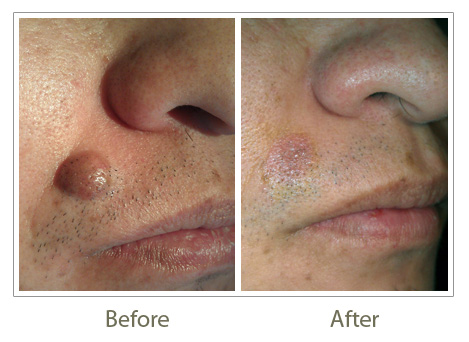Skin tag and mole removal by Radio Frequency
Radio Surgery is used to remove moles, warts, skin tags and other so called ‘lumps and bumps’. Using Radio frequency for skin tag removal is a minimally invasive technique. It involves the passage of radio waves into the skin to perform the removal or reshaping of a lesion. Different types of electrodes are used depending on the type of lesion, e.g. fine needle, wire loop, scalpel blade etc. Expect minor swelling, redness, bruising and tenderness in the area for a few days as it heals.
Radio Surgery background information
Moles, warts, skin tags and other so called ‘lumps and bumps’ can be both upsetting to look at and cause social and psychological unease for those whose face is blighted by such growths. With increases in the occurrence of skin cancers you should be well advised in advance to seek professional, medical advice about any growths which appear over night or change dramatically in appearance. Though most growths are benign and harmless, and removal is often quick and simple with reassuring cosmetic results.

Radio Frequency can be used to remove skin tag
Radiosurgery or Radiofrequency or Radiowave surgery is the cutting of tissues using a high frequency alternate current. This surgical modality is very different from traditional electrosurgery and other forms of electrocautery as it can simultaneiously cut and coagulate tissues without applying any pressure.
Traditional electrosurgery devices cut skin tissues using electric current which is passed through the patient and using the electrode tip to provide resistance, effectively causing high temperature heating of the electrode tip and excessive lateral.
The principle of radiofrequency or radiowave surgery is that it uses high frequency radiowaves, at 4.0 MHz, to deliver low temperatures through radiofrequency (RF) micro-fibre electrodes. The waveband utilized is similar to the frequency of marine band radios.
The difference between this method and electrosurgery is that the tissue serves as the resistance instead of the electrode. This means there is no heating of the RF micro-fibre electrode by the use of low temperature RF radiowave energy. Instead, the intracellular tissue water provides the resistance and vaporizes without the heat and damage seen in electrosurgery.
What is Radiofrequency Surgery useful for?

Skin tag removal by radio frequency
Radiofrequency surgery is extremely versatile and can be used in many medical specilities including General Surgery, Craniofacial Surgery, Neurosurgery along with others.
Uses of Radiofrequency in dermatosurgery:
- Removal of skin tags, warts seborrheic keratoses, syringoma, and trichoepithelioma.
- Removal of melanocytic nevi, telangectasias and early skin tumours.
- Skin biopsies and grafts.
- Resurfacing of scars
- Primary resection of keloids.
- Debulking of skin tumours.
- Resurfacing in case of Rhinophyma, Darier’s disease etc.
- Hair restoration surgery: scalp reduction, scalp lifting, scalp flaps.
- Non ablative face lift.
Advantages of radio-surgery include:
- Rapid healing.
- Minimal or no bleeding.
- Aesthetically pleasing scars or no scars.
- Lesser operating time
- Office/ Clinic procedure.
What happens during a Radio Surgery Operation
Radiofrequency surgery involves the passage of radio waves into the skin to perform removal or reshaping of a lesion. The radio waves are generated by a radiosurgery unit which creates a very high-frequency radio wave. The radio-surgical unit consists of an electrode, a ground place and a transformer.
The lesion should be touched with the tip of the electrode. It generates very little heat as compared to conventional electro-cautery. This results in negligible collateral damage resulting in faster healing and minimal scarring. When radio energy passes between the ground plate and the patient electrode it is concentrated at the electrode end resulting in the release of energy which produces steam within the cells thus vapourising them and dividing the tissues. The heat makes the intracellular water boil and thereby increases the cell inner pressure to the point of breaking it from the inside to the outside. This phenomenon is called a cellular volatization.

What are the risks and potential complications from Radio Surgery?
The actual procedures are generally well tolerated due to the administering of local anaesthesia. You may feel small tugging sensations in the area during treatment as the growth is removed but should not feel pain.
Expect minor swelling, redness, bruising and tenderness in the area for a few days as it heals. There should not however be any bleeding due to the tissue coagulation during treatment.
In very rare cases minor electrical shocks or burns can be experienced due to the patient coming in contact with another metal surface during treatment, such as touching a metal part of the bed.
Dr. Ashok Pandey from Bombay Cosmetic Clinic is a celebrated and revered personality in the field of cosmetic surgery. Currently conducting his cosmetic and aesthetic surgery practice in Navi Mumbai, he is associated with number of leading hospitals across the city where he regularly imparts his services to the needy.
Such is his expertise in his field of knowledge that he has successfully conducted more than thousand cosmetic practicing in South Mumbai and Navi Mumbai and plastic surgeries in his career so far.
For consultation call – 099307 31109 / 022 27801101


